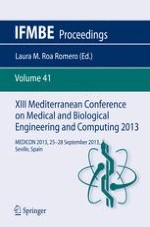2014 | OriginalPaper | Buchkapitel
Evaluation of Laplacian Diaphragm Electromyographic Recordings in a Static Inspiratory Maneuver
verfasst von : L. Estrada, A. Torres, J. Garcia-Casado, Y. Ye-Lin, R. Jané
Erschienen in: XIII Mediterranean Conference on Medical and Biological Engineering and Computing 2013
Aktivieren Sie unsere intelligente Suche, um passende Fachinhalte oder Patente zu finden.
Wählen Sie Textabschnitte aus um mit Künstlicher Intelligenz passenden Patente zu finden. powered by
Markieren Sie Textabschnitte, um KI-gestützt weitere passende Inhalte zu finden. powered by
Diaphragm electromyography (EMGdi) provides important information on diaphragm activity, to detect neuromuscular disorders of the most important muscle in the breathing inspiratory phase. EMGdi is habitually recorded using needles or esophageal catheters, with the implication of being invasive for patients. Surface electrodes offer an alternative for the non-invasive assessment of diaphragm activity. Ag/AgCl surface disc electrodes are used in monopolar or bipolar configuration to record EMGdi signals. On the other hand, Laplacian surface potential can be estimated by signal recording through active concentric ring electrodes. This kind of recording could reduce physiological interferences, increase the spatial selectivity and reduce orientation problems in the electrode location. The aim of this work is to compare EMGdi signals recorded simultaneously with disc electrodes in bipolar configuration and a Laplacian ring electrode over chest wall. EMGdi signal was recorded in one healthy subject during a breath hold maneuver and a static inspiratory maneuver based on Mueller’s technique. In order to estimate the covered frequency range and the degree of noise contamination in both bipolar and Laplacian EMGdi signals, the cumulative percentage of the power spectrum and the signal to noise ratio in sub-bands were determined. Furthermore, diaphragm fatigue was evaluated by means of amplitude and frequency parameters. Our findings suggest that Laplacian EMGdi recording covers a broader frequency range although with higher noise contamination compared to bipolar EMGdi recording. Finally, in Laplacian recording fatigue indexes showed a clearer trend for muscle fatigue detection and also a reduced cardiac interference, providing an alternative to bipolar recording for diaphragm fatigue studies.
